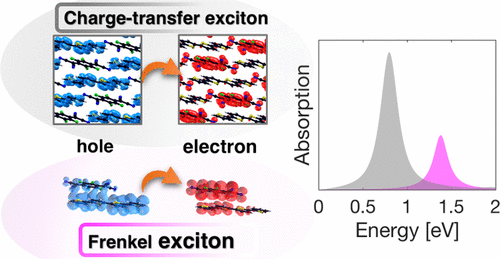当前位置:
X-MOL 学术
›
J. Phys. Chem. C
›
论文详情
Our official English website, www.x-mol.net, welcomes your
feedback! (Note: you will need to create a separate account there.)
Long-Range Order Promotes Charge-Transfer Excitations in Donor/Acceptor Co-Crystals
The Journal of Physical Chemistry C ( IF 3.3 ) Pub Date : 2021-09-15 , DOI: 10.1021/acs.jpcc.1c06969 Michele Guerrini 1, 2 , Ana M. Valencia 1, 2 , Caterina Cocchi 1, 2
The Journal of Physical Chemistry C ( IF 3.3 ) Pub Date : 2021-09-15 , DOI: 10.1021/acs.jpcc.1c06969 Michele Guerrini 1, 2 , Ana M. Valencia 1, 2 , Caterina Cocchi 1, 2
Affiliation

|
Electronic and optical properties of doped organic semiconductors are dominated by local interactions between donor and acceptor molecules. However, when such systems are in crystalline forms, long-range order competes against short-range couplings. In a first-principles study on three experimentally resolved bulk structures of quaterthiophene doped with (fluorinated) tetracyanoquinodimethane, we demonstrate the crucial role of long-range interactions in donor/acceptor co-crystals. The band structures of the investigated materials exhibit direct band gaps decreasing in size with increasing amount of F atoms in the acceptors. The valence band maximum and conduction band minimum are found at the Brillouin zone boundary and the corresponding wavefunctions are segregated on donor and acceptor molecules, respectively. With the aid of a tight-binding model, we rationalize that the mechanisms responsible for these behaviors, which are ubiquitous in donor/acceptor co-crystals, are driven by long-range interactions. The optical response of the analyzed co-crystals is highly anisotropic. The absorption onset is dominated by an intense resonance, corresponding to a charge-transfer excitation. Long-range interactions are again responsible for this behavior, which enhances the efficiency of the co-crystals for photo-induced charge separation and transport. In addition to these results, our study clarifies that cluster models, accounting only for local interactions, cannot capture the relevant impact of long-range order in donor/acceptor co-crystals.
中文翻译:

长程有序促进供体/受体共晶中的电荷转移激发
掺杂有机半导体的电子和光学特性由供体和受体分子之间的局部相互作用决定。然而,当这样的系统处于晶体形式时,长程有序与短程耦合竞争。在对掺杂有(氟化)四氰基醌二甲烷的四噻吩的三个实验分辨的块体结构的第一性原理研究中,我们证明了供体/受体共晶中长程相互作用的关键作用。所研究材料的能带结构表现出直接带隙尺寸随着受体中 F 原子数量的增加而减小。在布里渊区边界处发现了价带最大值和导带最小值,并且相应的波函数分别在供体和受体分子上分离。在紧束缚模型的帮助下,我们将导致这些行为的机制合理化,这些行为在供体/受体共晶中无处不在,是由长程相互作用驱动的。分析的共晶的光学响应是高度各向异性的。吸收开始由强烈共振主导,对应于电荷转移激发。长程相互作用再次导致这种行为,这提高了共晶用于光诱导电荷分离和传输的效率。除了这些结果之外,我们的研究还阐明了仅考虑局部相互作用的簇模型无法捕获供体/受体共晶中长程有序的相关影响。在供体/受体共晶中无处不在,由长程相互作用驱动。分析的共晶的光学响应是高度各向异性的。吸收开始由强烈共振主导,对应于电荷转移激发。长程相互作用再次导致这种行为,这提高了共晶用于光诱导电荷分离和传输的效率。除了这些结果之外,我们的研究还阐明了仅考虑局部相互作用的簇模型无法捕捉供体/受体共晶中长程有序的相关影响。在供体/受体共晶中无处不在,由长程相互作用驱动。分析的共晶的光学响应是高度各向异性的。吸收开始由强烈共振主导,对应于电荷转移激发。长程相互作用再次导致这种行为,这提高了共晶用于光诱导电荷分离和传输的效率。除了这些结果之外,我们的研究还阐明了仅考虑局部相互作用的簇模型无法捕获供体/受体共晶中长程有序的相关影响。长程相互作用再次导致这种行为,这提高了共晶用于光诱导电荷分离和传输的效率。除了这些结果之外,我们的研究还阐明了仅考虑局部相互作用的簇模型无法捕获供体/受体共晶中长程有序的相关影响。长程相互作用再次导致这种行为,这提高了共晶用于光诱导电荷分离和传输的效率。除了这些结果之外,我们的研究还阐明了仅考虑局部相互作用的簇模型无法捕获供体/受体共晶中长程有序的相关影响。
更新日期:2021-09-30
中文翻译:

长程有序促进供体/受体共晶中的电荷转移激发
掺杂有机半导体的电子和光学特性由供体和受体分子之间的局部相互作用决定。然而,当这样的系统处于晶体形式时,长程有序与短程耦合竞争。在对掺杂有(氟化)四氰基醌二甲烷的四噻吩的三个实验分辨的块体结构的第一性原理研究中,我们证明了供体/受体共晶中长程相互作用的关键作用。所研究材料的能带结构表现出直接带隙尺寸随着受体中 F 原子数量的增加而减小。在布里渊区边界处发现了价带最大值和导带最小值,并且相应的波函数分别在供体和受体分子上分离。在紧束缚模型的帮助下,我们将导致这些行为的机制合理化,这些行为在供体/受体共晶中无处不在,是由长程相互作用驱动的。分析的共晶的光学响应是高度各向异性的。吸收开始由强烈共振主导,对应于电荷转移激发。长程相互作用再次导致这种行为,这提高了共晶用于光诱导电荷分离和传输的效率。除了这些结果之外,我们的研究还阐明了仅考虑局部相互作用的簇模型无法捕获供体/受体共晶中长程有序的相关影响。在供体/受体共晶中无处不在,由长程相互作用驱动。分析的共晶的光学响应是高度各向异性的。吸收开始由强烈共振主导,对应于电荷转移激发。长程相互作用再次导致这种行为,这提高了共晶用于光诱导电荷分离和传输的效率。除了这些结果之外,我们的研究还阐明了仅考虑局部相互作用的簇模型无法捕捉供体/受体共晶中长程有序的相关影响。在供体/受体共晶中无处不在,由长程相互作用驱动。分析的共晶的光学响应是高度各向异性的。吸收开始由强烈共振主导,对应于电荷转移激发。长程相互作用再次导致这种行为,这提高了共晶用于光诱导电荷分离和传输的效率。除了这些结果之外,我们的研究还阐明了仅考虑局部相互作用的簇模型无法捕获供体/受体共晶中长程有序的相关影响。长程相互作用再次导致这种行为,这提高了共晶用于光诱导电荷分离和传输的效率。除了这些结果之外,我们的研究还阐明了仅考虑局部相互作用的簇模型无法捕获供体/受体共晶中长程有序的相关影响。长程相互作用再次导致这种行为,这提高了共晶用于光诱导电荷分离和传输的效率。除了这些结果之外,我们的研究还阐明了仅考虑局部相互作用的簇模型无法捕获供体/受体共晶中长程有序的相关影响。











































 京公网安备 11010802027423号
京公网安备 11010802027423号